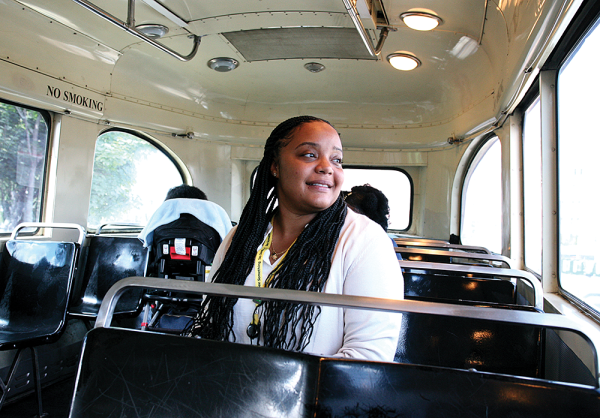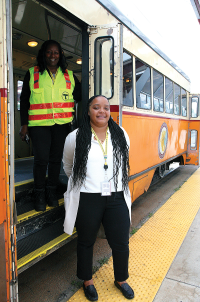August 28, 2024

Alicia Gomes, the first-ever MBTA executive director of light rail, took a ride on the Mattapan Trolley last week while speaking about how she approaches her new role.
Seth Daniel photos

Alicia Gomes, who was recently appointed as the MBTA’s first-ever director of Light Rail after General Manager Phillip Eng separated the operations of heavy rail like the Red Line from light rail, which includes the entire Green Line and the Mattapan Trolley, brings first-hand experience to the job.
The 39-year-old Dorchester resident started her 17-year-career with the T driving trolleys on the Mattapan Hi-Speed line and later operated Green Line cars.
“I feel like having ridden on it, driven it, and everything – growing up here and taking the line as a student – it increases accountability and ownership because my family and friends use it,” she said.
“They use it getting around Dorchester. You don’t want things to happen to anyone on your watch. But if something happens, I know it could be my grandmother or my brother or my mother that is on that train. I bring that perspective to the position.”
As an operator and, more recently, a manager, Gomes has gained a ton of worker support along the way.

New Light Rail Executive Director Alicia Gomes (front) exiting the Mattapan Trolley at Mattapan Station with long-time friend and colleague Annette Gonsalves-Byner – a Mattapan resident who has been a Green Line supervisor for 22 years. Seth Daniel photos
She grew up in Uphams Corner and attended the Edward Everett School and the Richard J. Murphy School – both in Dorchester. She went to high school in the Back Bay and used the Green Line to get to school, relying on it not to be tardy. And as a teen, she learned how to use the Mattapan Trolley instead of the bus to get to her job in Mattapan Square.
“Having done those things on the T as a young person, it gives you a whole different perspective as an executive director,” she noted. “It’s not just people trying to get to work that you’re thinking about, but also the kids that depend on the T to get to school. You feel that.”
Gomes says that Eng’s decision to separate the management of light rail from heavy rail is an inspired one because “our operators are more in contact with the public in a way that’s more like a bus, interacting with customers and seeing regular riders. This change gives us the operational ability to start from the ground up and say this is how light rail should be.
She added, “Heavy rail operators are in a cab and don’t interact as much. We’re also often mixed in with traffic on the Green Line, and we have at-grade crossings here on the Mattapan line. She noted, too, that light rail operates without a third rail and with overhead wires and is also subject to weather variabilities.
During an interview while riding the Mattapan Trolley last week with The Reporter, Gomes said her favorite assignment as a driver was the trolley. She’d “probably still be driving it today” if her lack of seniority hadn’t bumped her to the Green Line. “I always thought it was a great line to get people from point A in Ashmont to point B in Mattapan and every stop in between,” she said.
The Mattapan line will see a dramatic change in the coming years as the MBTA proceeds with a $127 million reconstruction project that will, over time, replace the existing vintage PCC cars with newer Type 9 light rail cars that are now in service on the Green Line. This fall, the MBTA expects to provide the community with an updated timeline for the Type 9 vehicle deployment, and MBTA managers have been working to develop an accelerated project schedule.
Gomes confesses that the change in rolling stock will bittersweet — she’ll miss the nostalgia of the old trolley cars— but she is convinced the newer cars will improve operations.
“I am absolutely excited about that work,” she said. “Anytime we can offer reliable service that is more efficient and more accessible, I am going to be excited about that.”
The biggest improvement will be enhanced accessibility, as the Type 9 trains will not have steps and boarding will be level with the ground.
Last October, the agency made major improvements to the track during a planned shutdown that also focused on the subway section of the Red Line in Dorchester. Gomes said that in her 17 years as a driver, manager, and chief, “we always had speed restrictions, but I don’t know if we’ve ever seen as much commitment to end that as we see now.
“The T needs the ridership and people to come back. I think we’re seeing that now and it’s great to see…The hope is we get back to where we were, and public transit is understood as a necessity and people believe in it to get them to where they need to go. That’s where we’re headed. I believe that as a worker, and I can say it after spending 17 years here.”
A previous version of this story indicated Type 9 trolleys could be deployed as early as 2026, but that is inaccurate. Timelines are expected to be revealed in the fall.
Villages:


